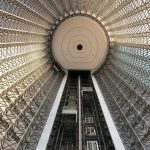Control of suspension metal ropes
By Nicola Imbimbo – Read the author’s biography
Article appeared for the first time on Elevatori, n. 6/2005
ABSTRACT
This paper aims at suggesting criteria and basic references for examining metal ropes for lifts, paying special attention to signals given by an operating rope. The metal rope is a ‘friendly’ component when a damage has to be detected, there are a number of signs showing the progress of a damage, which is detectable long before the occurrence of any dangerous situation.
Very often slipping occurrences are ascribed only to metal ropes, while the actual causes derive from other elements: fleet angles, rope structure, worn pulleys, different tensioning of various ropes, etc.
1 – INTRODUCTION
The metal rope is often identified as an ‘obscure’ element, whose condition is difficult to assess.
In many cases concerning the periodic assessment reports on lift systems, it is read: “keep suspension ropes under observation”.
The aim of this paper is to identify basic criteria for a metal rope periodic assessment based on objective evaluations, in order to keep suspension ropes under observation.
The items related to metal ropes are so complex and difficult that this paper is not intended to be fully exhaustive, but to serve only as a guideline.
2 – ASSESSMENT OF METAL ROPES FOR LIFTS
The method for the assessment of lift metal ropes is essentially based on the review of several elements in order to assess their preservation conditions:
• measure of rope effective diameter
• evaluation of number of broken wires
• oxidation
• permanent distortion/deformation of rope body
• lifting of the wires
• assessment of surface condition
• measure of rope lay.
Also the elements where the rope is situated require special attention, therefore also the condition of pulley grooves, especially traction pulleys, must be checked.
All these series of elements allow the whole assessment of the condition and the wear and tear of the rope.
It is not enough to constrain the analysis to only few of them. They all must be taken into account (i.e. it is not sufficient to detect the number of broken wires, neglecting the effective diameter of the rope).
The Presidential Decree 1497/63 is the Italian reference still in force stating the criteria for replacing suspension ropes.
The Italian Ministerial Decree 587/87 , the Italian Pres. Decrees 268/94 and 162/99 are the enforcement of Community Directives which do not deal with the rope wear and tear, because they are only focused on new lift systems. The evaluation of the conditions of metal ropes is a maintenance operator’s duty as required by the Presidential Decree 162/99 art. 15.3b; moreover, the person charged by the lift owner with the installation Periodical Verification (this verification must be carried out every two years) has to carry out the same type of control of the metal rope condition (Presidential Decree162/99 art.13).
Below, some criteria and relevant reference to the legislation are presented.
3 – CRITERIA FOR EVALUATION OF LIFT METAL ROPES
In order to understand the basic criteria for these evaluations, we need to start from fundamentals by examining the legislative requirements:
Art. 20 of Italian Legislative Decree, 31 August 1945 No.600:
“The rope replacement shall be carried out by the lift or goods lift owner as soon as the need arises.
In case of dispute about this need, ropes must be replaced without any doubt when the safety ratio is less than four fifth (4/5) compared to the one taken as reference for the calculation.
The assessment of the safety value left must be carried out, by taking as breaking load of the rope the initial one reduced by the breaking load relevant to the double amount of the sections of broken wires, resulting from the outer examination of the rope, comprised in a rope length not exceeding four rotations of the wire in the strand”.
Art.39 of Italian Presidential Decree 1497/63:
“The suspension ropes showing evident wear and tear, or an excessive number of broken wires, must be replaced.
In case of doubt relevant to the need for replacing the suspension ropes, these must be replaced when the most worn section, for a length equal to 10 rope diameters for 6-strand ropes and 8 diameters for 8-strand ropes, the visible broken wires have an overall section greater than 10% of the rope total metal section”.
From the above, the process seems quite complex: the inspector should acquire a series of technical data on the metal rope, make calculations and evaluations in order to obtain the percentage of worn out metal rope.
Actually some technical standards were issued making this calculation much easier as to the maximum quantity of allowed broken wires (ISO 4344:2004 Steel Wire Ropes for Lifts – Minimum Requirements. Annex E “Discard Criteria for Lift Ropes).
We have also to take into consideration that the simple research of the broken wires number only is not enough in order to assess the condition of the rope, considering the high rope/pulley ratio (1:40), the number of broken wires will be very rarely sufficient. On the contrary it is important to look for other signs of degradation, such as corrosion, wear and tear, lengthening of the roping lay, etc…



